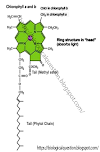Lysosomes
Lyso means splitting and soma means body. These are single membranous, spherical vesicles. They
contain digestive or hydrolytic enzymes.
Formation of Lysosomes:
The lysosomal enzymes are made by the RER and then are
transported to Golgi complex through SER. After modification, these enzymes are released from the
trans face Golgi complex in the form of vesicles. Such vesicles are called lysosomes. The newly formed
lysosomes before the start of their functions are usually called primary lysosomes. In plants and fungi,
certain vacuoles carryout enzymatic hydrolysis, a function shared by lysosomes in animal cells.
 Lysosome : Formation and Function
Lysosome : Formation and Function
Function of Lysosome:
Lysosomes contain about 40 different digestive enzymes. These enzymes can breakdown every major
macromolecule of the cell. The contents of the lysosome are acidic. In order to perform its function the
lysosomes fuses with membrane bound vesicle that arises from any of these pathways endocytosis,
phagocytosis or autophagocytosis. These vesicles are referred to as endosomes, phagosomes and
autophagosomes respectively. These endosomes fuses with lysosomes (primary lysosomes) and forms
secondary lysosomes. The bio-molecules are further broken down into smaller forms like amino acids,
monosaccharides, nucleotides and fatty acids which are then recycled in the cell. Major functions of
lysosomes include intracellular digestion, autophagy, autolysis and sometimes release of extra cellular
enzymes.
The ingested food of cell is stored in vesicles, called food vacuoles. Once a lysosome has fused with food
vacuole, the resulting structure is called secondary lysosome in which food begins to digest. The digested
products are absorbed by the cytoplasm while the remaining wastes containing vesicle is now called
contractile vacuole. Later on these vacuoles fuse with cell membrane (exocytosis) to eliminate
undigested wastes. This whole process is known as intracellular digestion.
The process by which unwanted structures within the cell are engulfed and digested within the
lysosomes is called autophagy. This is self-eating process of a cell in which a lysosome begins to digest
cell's own organelles. Such lysosomes are also called autophagosomes. This process either takes place in
starvation period in order to obtain energy or it occurs in routine in order to control number of specific
organelle. For example: If someone starts to perform heavy muscular exercise, the number of
mitochondria begins to increase in his muscle cells, but if he leaves exercise, the number of
mitochondria are again decreased by the process of autophagy.
Sometimes, especially during developmental phase, when a particular cell is required to be
disintegrated, a type of cell death is committed, called autolysis. This is a programmed cell death in
which lysosomes burst and their enzyme contents are quickly dispersed throughout the cytoplasm. In
this way the cell is disintegrated into fragments which are phagocytosed by other cells. Due to this
function lysosomes are also called suicidal bags.



.png)


0 Comments